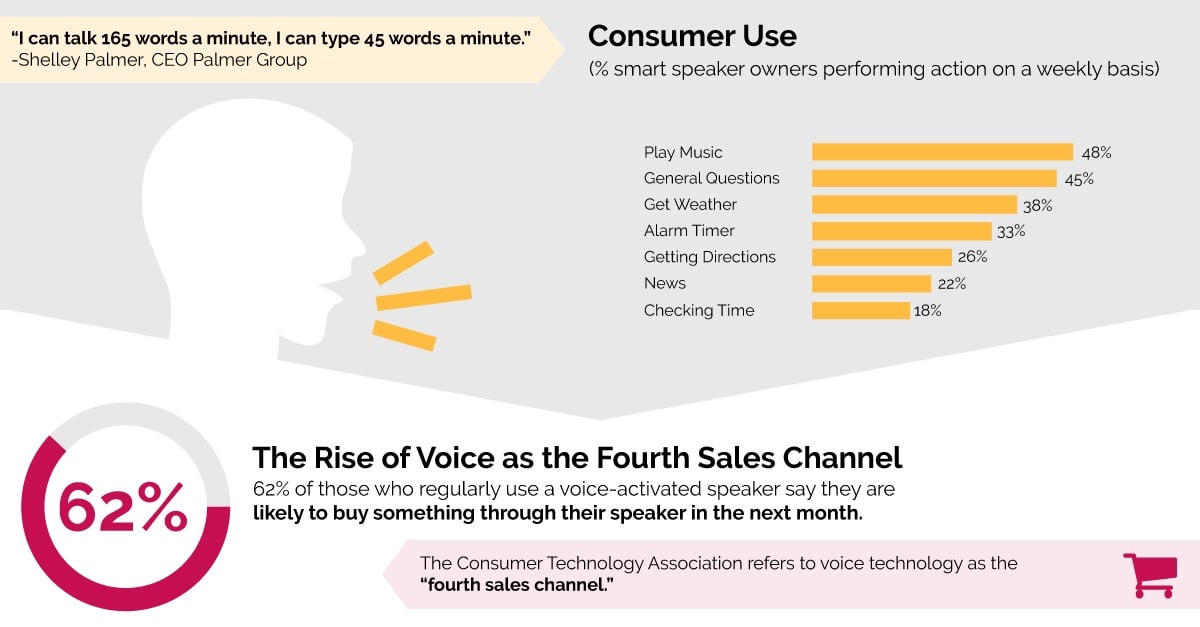“Alexa: do you remember the last consumer tech “must-have product” to hit the shelves?”
According to the Consumer Technology Association (CTA), it was the iPhone (2007) and iPad (2012). And now voice-controlled smart speakers, like the Amazon Echo and Google Home, have achieved that coveted status. CTA predicts 56.6 million smart speakers will be sold in the US next year; two years ago that number was just 7.2 million!.
Voice technology is set to fundamentally change the environment in which consumers make decisions, and who (or what) influences that decision. To stay ahead of the competition, brands will need to exhaust every opportunity to optimize their position in this new “4th sales channel” of voice commerce.
Do you know how voice searches for your product category begin?
In “ ,” we explore marketing challenges and opportunities voice poses for brands, such as eCommerce and decision journey implications. Here I’m sharing three tips from our guide to optimize your brand’s voice commerce strategy:
,” we explore marketing challenges and opportunities voice poses for brands, such as eCommerce and decision journey implications. Here I’m sharing three tips from our guide to optimize your brand’s voice commerce strategy:
1. Explore how voice search rankings and algorithms can help you gain favor with Alexa & Google Assistant
Brands that don’t make the first one or two suggested results from Alexa or Google have essentially received a death sentence. If you don’t want that #3 or worse position, your approach to insights and analytics will need to expand beyond ‘traditional’ online retailers and brick-and-mortar stores.
In order to build a strong, truly omnichannel, brand presence, you need to understand and maximize not only desktop and mobile search algorithms, but now learn how voice search results across Amazon and Google platforms.
For example, there’s evidence that Amazon programs search results differently for Echo voice searches than they do for manual searches, giving lower prices for their own products and limiting the alternative brands/products available for purchase. Additionally, research shows that once consumers become accustomed to using voice, easy access to Amazon Prime and Google Express increases the likelihood that they will make purchases based on what is immediately available to them on these platforms.
2. Create unique voice experiences
While it’s no small feat, the most revolutionary aspect of voice technology is that it places renewed pressure on you to make your brand synonymous with your products (think Kleenex and facial tissue). Consumer associations must be so strong that they inspire brand-specific searches over generic ones, which are far more common in the ‘conversational’ nature of voice searches.
By creating a “voice brand” that is useful, interactive, and appealing, you will optimize your position in voice searches. The best way to start this process is to identify when and where consumers might use the technology to find or interact with your product and what opportunities exist to attract, convert or retain customers in this channel. Clorox and Campbell’s Soup have already drawn attention for how well they have done this, showcasing voice skills that provides custom cleaning instructions and step-by-step recipes.
3. Capture early pattern information for predictive analytics

Prioritize learning the new and different types of data that voice commerce provides. For example, be mindful of the increasingly valuable data contained in the shopping and wish lists created by virtual assistants. Combined with quantitative and/or qualitative research data, the aggregated patterns from these lists may provide significant, if not revolutionary, insights into shopping triggers and how consumer decision behavior is being disrupted by this technology.
Want to learn more about voice technology as the fourth sales channel?  and let us know how we can help support your brand in this exciting space.
and let us know how we can help support your brand in this exciting space.


